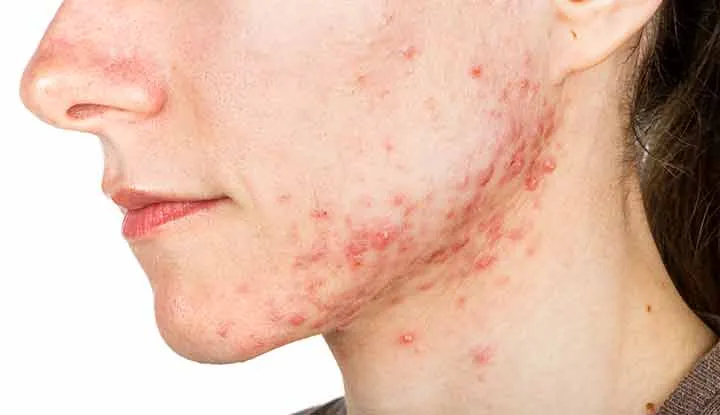
Acne is very common and can be an irritating or unsightly problem of teenagers and adulthood. While the severe form of acne is relatively uncommon; painful and emotionally distressing because of its appearance on faces; and can greatly affect a person’s self-image and self-esteem. Severe acne is generally defined by having cysts and nodules; with numerous or extensive papules and pustules. Severe acne mainly occurs due to fluctuation in hormone levels, more common during puberty, and more frequently seen in men than women; though can occur at any age. Although it is much difficult to treat, requires extensive treatment and the struggle against it can sometimes be exhausting.
As the skin has numerous pores and that have oil-secreting glands called sebaceous glands that secrete sebum, Sebum keeps the skin hydrated and normally protects hair follicles. Due in course of overproduction of this sebum and increase in dead skin cells can cause plugging of these pores, leading to non-inflammatory acne whiteheads, blackheads. These clogged pores provide favorable conditions for commensal bacteria, Propionibacterium acnes to grow and gets trapped underneath the skin, leading to infection and inflammation. As the follicle enlarges, the wall may rupture into a deeper layer of the skin resulting in an inflammatory type of acne (pimples-papules & pustules in which the inflammation is on the skin surface and severe acne in which the inflammation is still deeper called nodules and cyst. Cysts are the most inflamed and ruptured type of acne.
The most common cause for increased secretion of sebum is hormonal changes, as seen in puberty, during menstrual cycles, pregnancy, hormone therapy, and stress. Other few causes influencing the sebum secretion are genetics, intake of certain medicines such as corticosteroid, exposure to harmful chemicals, high levels of humidity and sweating, greasy cosmetics, consumption of oily, spicy and carbohydrate-rich diet.
There are many types of severe acne; the four most common among them are:
This acne is an inflamed cyst with pain, large bumps filled with pus, fluid, or some other material. These may occur independently or have large groups of cyst clustered together and are difficult to treat.
It is a rare and unusually severe form of nodulocystic acne. It occurs when painful cysts get connected beneath the skin, creating visible and even disfiguring scars. Acne conglobata is chronic, persist for months, and need to treat aggressively to prevent significant damage to the skin in the form of infected nodules, deeply inflamed abscesses, and scarring.
Acne fulminans is a more severe type of acne conglobata. This type is characterized by sudden and severe inflammation affecting the entire body, most commonly seen in males during puberty. The associated symptoms may be fever, joint pain, bleeding ulcers, loss of appetite, weight loss, etc.
Gram-negative folliculitis is a type of infection that doesn’t respond to many antibiotics and can be difficult to treat. It occurs when follicles in the skin become inflamed from an infection caused by Gram-negative bacteria.
If all these severe forms of acne not treated in time, it can cause severe damage to the underlying skin and scarring, make you emotional distress due to its appearance on the face; and can greatly affect a person’s self-image and self-esteem. All these severe acne should be managed by an expert skin professional.
Clear Skin Centre has a long term experience, and expertise to treat difficult and severe types of acne.
As dealt before severe acne is recalcitrant to the usual line of treatment and will require experts to manage; still, some of the available treatments are mentioned below:
Systemic medications: oral medication is recommended with or without topical medicines to enhance the results.
Antibiotics are useful in controlling bacterial infection and reducing inflammation and are advisable to be used for a short duration to avoid bacterial resistance.
Retinoids Isotretinoin is the first-line of treatment for severe acne and works immediately reducing the sebum flow by inhibiting the active sebaceous glands, which is the main culprit in initiating the formation of acne. Due to its potential adverse effects in child bearing, age groups need dermatologist supervision.
Birth control pills Acne occurs over the lower part of the face such as mandibular area or due to hormonal fluctuations; oral contraceptive pills containing a low level of estrogen and progesterone hormones can be used for a period of six months to suppress sebum production.
Interventional therapy: such as chemical peeling, intralesional steroids, incision & drainage, photodynamic therapy, laser treatment, may require in resistant cases of acne not responding to above-mentioned measures and therapy
Chemical peels: Dermatologists use a strong chemical solution to the skin, which is overtime, peels the top layers of the skin, and even blocked clogs or blackheads, which may help sometime.
Intralesional injection of the corticosteroid like triamcinolone into a cyst can help reduce inflammation and prevent scarring. After the injection, the acne cysts will usually shrink and improve over several days. It is essential to be used in conjunction with other treatments to treat the actual infection in the cysts.
Incision and DrainageIf the cysts are large and painful, it may need to be open with a small incision and drain out the infected fluid. This is the best effective procedure is quick and painless, need to be done under aseptic condition.
Laser treatment: Intense pulse light (IPL) and Long pulse Nd: Yag are effective in less severe type of acne in combination with topical and systemic treatment; it requires multiple sessions and is expensive.
Isolaz Isolaz a painless technology combines vacuum with a broadband light. The laser device cleanses the pores by vacuuming and extracting the debris and excess oil from deep within your pores. Then the light helps destroy acne-causing bacteria, as well as reducing facial redness.
As discussed before, the course of severe acne treatment is extensive and so it is advised to follow a few general measures listed below for those suffering from mild acne.
